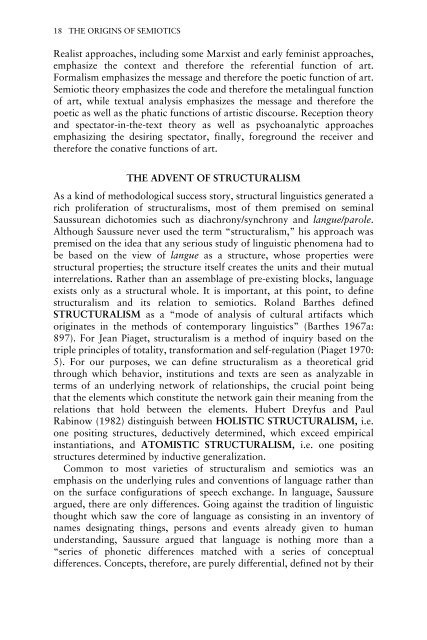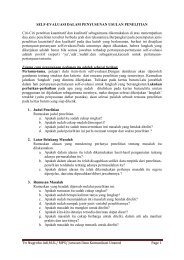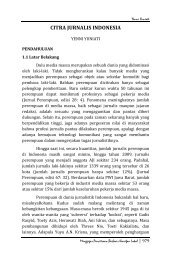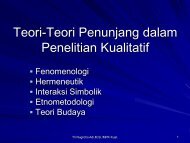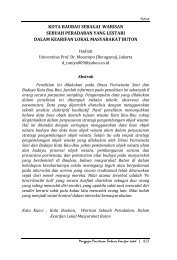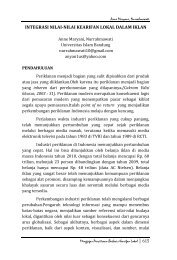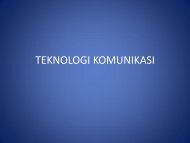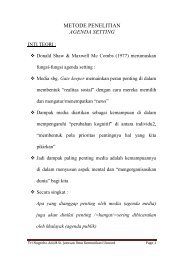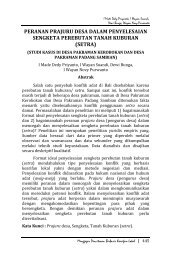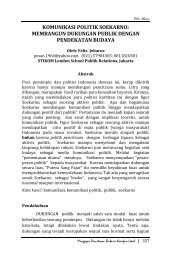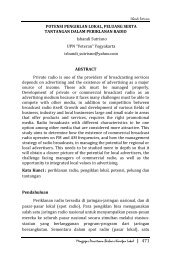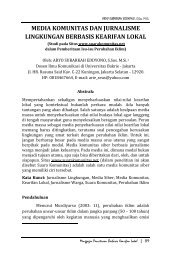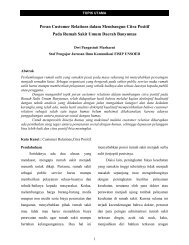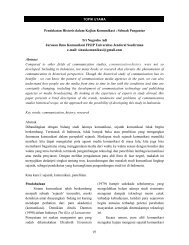New Vocabularies in Film Semiotics
New Vocabularies in Film Semiotics
New Vocabularies in Film Semiotics
You also want an ePaper? Increase the reach of your titles
YUMPU automatically turns print PDFs into web optimized ePapers that Google loves.
18 THE ORIGINS OF SEMIOTICS<br />
Realist approaches, <strong>in</strong>clud<strong>in</strong>g some Marxist and early fem<strong>in</strong>ist approaches,<br />
emphasize the context and therefore the referential function of art.<br />
Formalism emphasizes the message and therefore the poetic function of art.<br />
Semiotic theory emphasizes the code and therefore the metal<strong>in</strong>gual function<br />
of art, while textual analysis emphasizes the message and therefore the<br />
poetic as well as the phatic functions of artistic discourse. Reception theory<br />
and spectator-<strong>in</strong>-the-text theory as well as psychoanalytic approaches<br />
emphasiz<strong>in</strong>g the desir<strong>in</strong>g spectator, f<strong>in</strong>ally, foreground the receiver and<br />
therefore the conative functions of art.<br />
THE ADVENT OF STRUCTURALISM<br />
As a k<strong>in</strong>d of methodological success story, structural l<strong>in</strong>guistics generated a<br />
rich proliferation of structuralisms, most of them premised on sem<strong>in</strong>al<br />
Saussurean dichotomies such as diachrony/synchrony and langue/parole.<br />
Although Saussure never used the term “structuralism,” his approach was<br />
premised on the idea that any serious study of l<strong>in</strong>guistic phenomena had to<br />
be based on the view of langue as a structure, whose properties were<br />
structural properties; the structure itself creates the units and their mutual<br />
<strong>in</strong>terrelations. Rather than an assemblage of pre-exist<strong>in</strong>g blocks, language<br />
exists only as a structural whole. It is important, at this po<strong>in</strong>t, to def<strong>in</strong>e<br />
structuralism and its relation to semiotics. Roland Barthes def<strong>in</strong>ed<br />
STRUCTURALISM as a “mode of analysis of cultural artifacts which<br />
orig<strong>in</strong>ates <strong>in</strong> the methods of contemporary l<strong>in</strong>guistics” (Barthes 1967a:<br />
897). For Jean Piaget, structuralism is a method of <strong>in</strong>quiry based on the<br />
triple pr<strong>in</strong>ciples of totality, transformation and self-regulation (Piaget 1970:<br />
5). For our purposes, we can def<strong>in</strong>e structuralism as a theoretical grid<br />
through which behavior, <strong>in</strong>stitutions and texts are seen as analyzable <strong>in</strong><br />
terms of an underly<strong>in</strong>g network of relationships, the crucial po<strong>in</strong>t be<strong>in</strong>g<br />
that the elements which constitute the network ga<strong>in</strong> their mean<strong>in</strong>g from the<br />
relations that hold between the elements. Hubert Dreyfus and Paul<br />
Rab<strong>in</strong>ow (1982) dist<strong>in</strong>guish between HOLISTIC STRUCTURALISM, i.e.<br />
one posit<strong>in</strong>g structures, deductively determ<strong>in</strong>ed, which exceed empirical<br />
<strong>in</strong>stantiations, and ATOMISTIC STRUCTURALISM, i.e. one posit<strong>in</strong>g<br />
structures determ<strong>in</strong>ed by <strong>in</strong>ductive generalization.<br />
Common to most varieties of structuralism and semiotics was an<br />
emphasis on the underly<strong>in</strong>g rules and conventions of language rather than<br />
on the surface configurations of speech exchange. In language, Saussure<br />
argued, there are only differences. Go<strong>in</strong>g aga<strong>in</strong>st the tradition of l<strong>in</strong>guistic<br />
thought which saw the core of language as consist<strong>in</strong>g <strong>in</strong> an <strong>in</strong>ventory of<br />
names designat<strong>in</strong>g th<strong>in</strong>gs, persons and events already given to human<br />
understand<strong>in</strong>g, Saussure argued that language is noth<strong>in</strong>g more than a<br />
“series of phonetic differences matched with a series of conceptual<br />
differences. Concepts, therefore, are purely differential, def<strong>in</strong>ed not by their


